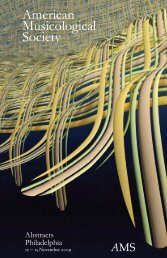Abstracts - American Musicological Society
Abstracts - American Musicological Society
Abstracts - American Musicological Society
Create successful ePaper yourself
Turn your PDF publications into a flip-book with our unique Google optimized e-Paper software.
34 Thursday Afternoon: Session 1- 30<br />
AMS/SEM/SMT New Orleans 2012<br />
the intersubjective experience of music as a mutual “tuning in” (Schutz, 1977[1951]; Porcello, 1998) to others through a concurrent<br />
experience of internal-time consciousness. The present moment is built upon retention of the moments preceding it and<br />
a protention of the expected moments to come. This results in an experience of duration and time that is malleable, and that<br />
is a prime site for the creation of meaning. In the case of the Irish singing session the interactive experience of the moment is<br />
one that is full of participatory discrepancies in the form of different tempos, pitches, and vocal qualities. Consequently this<br />
paper will address how this shared moment in song is experienced both individually and collectively, and how this experience<br />
shapes conceptions of performative time awareness for Irish traditional singers.<br />
Filling the Space: Field Hollers and the Social Role of Singers in African-<strong>American</strong> Communities<br />
Gianpaolo Chiriacò (University of Salento, Italy)<br />
Field hollers have been commonly deemed as a primary step in the historical evolution of African-<strong>American</strong> music. Nevertheless,<br />
the topic has never received the appropriate consideration. Some opinions regarding field hollers (such as their<br />
influence on blues) became widely accepted ideas, even though some prominent scholars were skeptical about them. As Paul<br />
Oliver’s definition suggests, field hollers established a relationship between voice and space. Following some pioneer studies on<br />
this relationship (by literary historians like Paul Zumthor and philosophers like Adriana Cavarero), my aim is at proving that<br />
field hollers implied a specific use of singing voice in the African-<strong>American</strong> context: not only a means of communication but<br />
also a peculiar means of self-expression. They constitute a specific combination of self-expression in English and musical figures<br />
related to their African origins: what Olly Wilson called “intensifiers”. Furthermore, nineteenth century sources—such as<br />
descriptions of corn-shucking ceremonies—prove that the social role of the most talented hollers-singers was prominent. They<br />
were acting as leaders of a community and they were allowed to talk to white people on its behalf. In other words, their voices<br />
were heard, recognized and accepted. In conclusion, analyzing the evolution of field hollers leads to a better understanding of<br />
the social role of singers in the development of African-<strong>American</strong> communities. As Walter Ong claimed: “Because of the very<br />
nature of sound as such, voice has a kind of primacy in the formation of true communities of men”.<br />
Session 1-30 (SEM), 1:45–3:45<br />
Film Session<br />
Songs of the New Arab Revolutions: A Collaborative Documentary Film by Members of the <strong>Society</strong><br />
for Arab Music Research and Members of the Facebook Group “Songs of the New Arab Revolutions”<br />
Michael Frischkopf (University of Alberta, Edmonton), Organizer<br />
Laith Ulaby (Independent Scholar), Jonathan Shannon (Hunter College, City University of New York)<br />
Music has not usually been understood as playing an active role in the grand moments of modern history. Yet, throughout<br />
the new Arab revolutions, from the onset of the Tunisian uprising, to ongoing struggles in Egypt, Syria, and elsewhere, music<br />
has consistently demonstrated its critical power to galvanize sentiment and mobilize civil society. Likewise, Arab political<br />
establishments have used music as an ideological tool for maintaining authority. In both cases music-in a wide array of<br />
styles—has played an active role in the unfolding of the Arab Spring. In June 2011 a Facebook group “Songs of the New Arab<br />
Revolutions” was founded, harnessing the power of social media to document and disseminate videos representing musical<br />
dimensions of these social movements. A filmmaking collective is presently creating a documentary film out of this Facebook<br />
archive, now including over 100 videos. Guided by the three presenters, each member of this collective is identifying a theme<br />
(e.g. “folk music”, “street protests”, “style”, “gender”) and editing a short illustrative segment, which the presenters will arrange<br />
into a film sifting, summarizing, and analyzing the phenomenon. This project is methodologically groundbreaking for: (a)<br />
drawing exclusively on an online archive assembled through social media; (b) catalyzing collaborative filmmaking among ethnomusicologists<br />
and community activists. The three presenters will introduce the project (15 minutes), show the film (1 hour),<br />
and lead discussion about the phenomenon, the film, and the method, exploring its wider implications for technologically<br />
mediated ethnomusicological engagement with current events and communities beyond academia (45 minutes).










